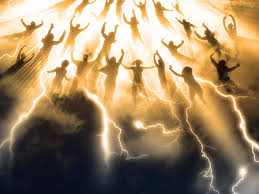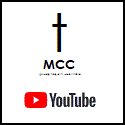
“For the Lord Himself will come down from heaven, with a loud command, with the voice of the archangel and with the trumpet call of God, and the dead in Christ will rise first. After that, we who are still alive and are left will be caught up together with them in the clouds to meet the Lord in the air. And so we will be with the Lord forever.” 1 Thessalonians 4:16-18
I saw a man that I barely ever knew, who knew I was a pastor. When he asked what I was doing for Halloween, I told Him I’d be home passing out candy. From the look on his face, you’d-a thought I’d murdered his baby! I was told, in no uncertain terms, that ‘Christians don’t celebrate Halloween!’ Really!???
The picture above looks spooky. Actually, it comes from a Christian website… the topic being ‘The Rapture!’ You know… the time when Christ returns to collect the church and take her home to Heaven to be His bride! The Rapture, the uniting of ALL Believers (dead and alive) together FOREVER is my greatest Joy. I’m hoping it’s tonight!
The following information is from is from this website (https://www.littlewaychapel.com/blog/all-hallows-eve#:~:text=For%20over%20a%20century%2C%20the,the%20race%20set%20before%20us). Here’s a summary:
A Beginners Guide to All Hallow’s Eve
All Hallows’ Eve is tonight, and while many celebrate Halloween with Trick-or-Treating or parties, it’s less common to celebrate October 31 as an actual day of Christian worship. So what is All Hallows’ Eve, exactly? It’s a term we hear a lot this time of year, but might think is interchangeable with “Halloween.” That’s true… in a way. The word “Halloween” comes from shortening “Hallow’s Eve”but it’s not just that. For Christians, there is a rich history, and Hope, here to take hold of.
Let’s start with the basics. What is a hallow? Well, hallow simply means holy, as the Lord’s Prayer suggests (“hallowed be thy name”), so a “hallow” is a holy person—a saint (EVERY Believer is considered a ‘Saint’ in God’s eyes). All Hallows’ Eve, then, is the eve of All Saints’ Day—the day the church remembers all the women and men from the past, from St. Peter to St. Augustine to St. Thérèse—who have modeled holiness for us throughout the history of the church.
All Saints’ Day is followed by All Souls’ Day on November 2, the day the church recognizes all the faithful departed—that is, every person who has ever lived and died in Christ, whether the church officially recognizes them as a saint or not. On All Souls’ Day, many churches hold services that specifically remember loved ones who have died in the last year.
For over a century, the Church has observed All Hallow’s Eve as an evening vigil to watch and wait for these two holy days that honor the friends, family, and heroic saints who are now part of the “cloud of witnesses” spoken of in Hebrews 12:1, cheering us on from heaven as we run the race set before us. All Hallows’ Eve is similar to Christmas Eve in that we are eagerly and festively anticipating the holy day that follows.
So, to recap: October 31 is All Hallows’ (Saints) Eve, November 1 is All Saints’ Day, and November 2 is All Souls’ Day. Got it? Good!
What is All Hallows’ Eve?
So, now that you’ve got the basics, you might be wondering how witches and goblins came to be associated with these holy days on the church’s calendar. Likely because October 31 through November 1 was the date of a Celtic festival called Samhain, which marked the end of the harvest season. The Gaels believed that beginning at sundown on October 31, the boundary between the dead and alive thinned, and the dead would return home seeking hospitality among the living. If the dead were not appeased, they would wreak havoc on livestock and crops, causing sickness and famine. So on October 31, the Gaels would don costumes, light bonfires, and imitate sorcery practices in order to ward off evil spirits and appease the dead. All hell would break loose and these festivals would often devolve into nights of havoc and terror.
In 835 the church supplanted this pagan festival, setting All Saints Day on November 1, the same day as Samhain. They replaced the havoc and mischief created by the evil dead on Samhain with a hopeful watching, waiting, and celebration of the holy dead, God’s saints.
This history presents us with two views of death: one as terrifying and haunted, the other as hopeful and holy. The church has chosen the latter, and on October 31 we make a party out of it. All Hallows’ Eve is an opportunity for Christians everywhere to celebrate the work God has done in and through his saints, and that neither their stories or ours will end in the grave.
I (K.C.) grew up trick or treating.. and I STILL love candy. We took OUR kids trick or treating. NONE of us turned into devils or worshiped satan! I had a difficult time trying to figure a way to tell my kids we would not be going door to door for candy… like their friends. It’s Candy… It’s a hint at The Rapture. It’s Fun!
So now you know! So why not go and do what you do in the Name of Jesus. And may I suggest that you NOT condemn people for doing things differently than you. Tell them about Jesus….if they don’t know Him… AND “The Rapture!” Personally, I can’t wait to see my Dad again! Oh… And eat some candy, if you’re allowed! It’ll make you sweet!



